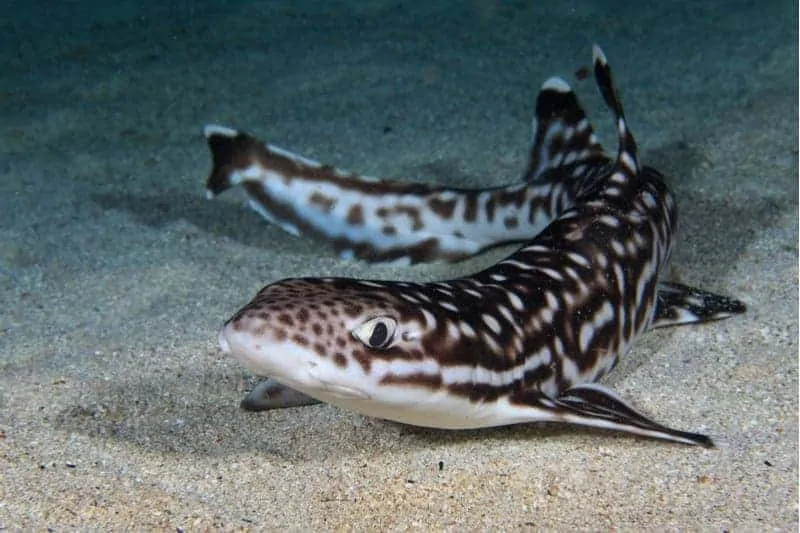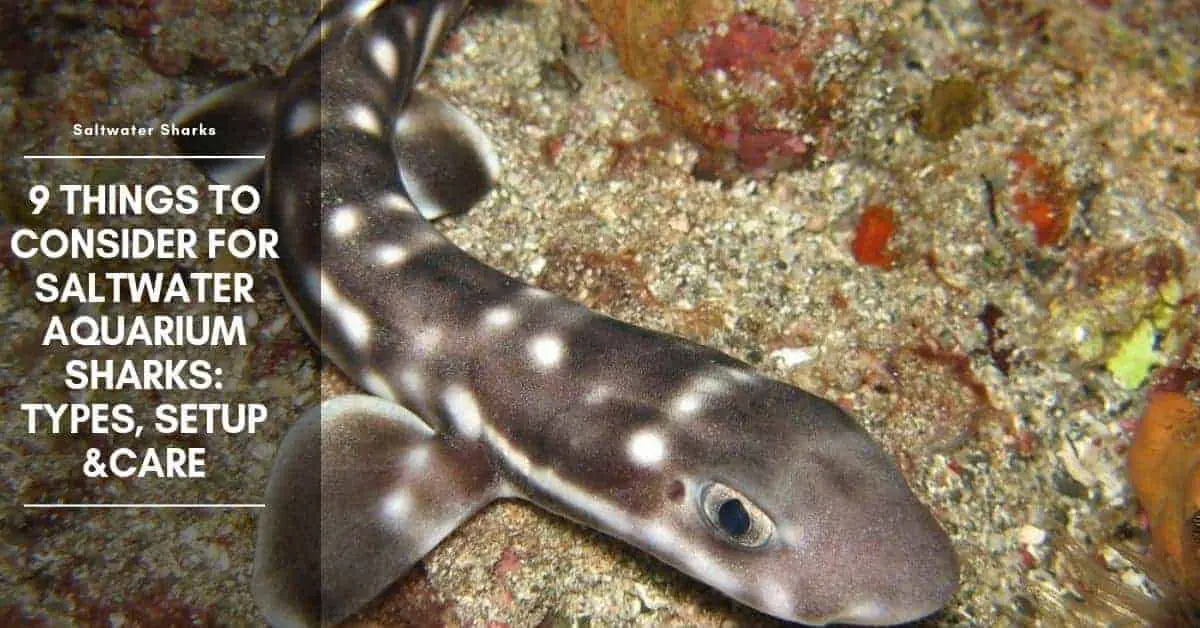Size Of The Saltwater Aquarium Shark Species
For these purposes, I’ll be talking about the small shark size species, this includes the Coral catshark which gets up to about 24 to a maximum of 30 inches. It’s a long slender shark and it does like to move around quite a bit.
Banded Cat Shark And Epaulette Shark
The Banded cat shark is another one, this one can get from 36 to even 40 inches on the top end, but more around 36 inches. And then the other one is the Epaulette shark. The Epaulette shark is known as the walking shark, it kind of likes to walk on his fins, and can get to be about 36 inches or 3 feet.
When we talk about these sharks and the size for the tank, the size of the shark is pretty important. For these sharks typically you’re going to be looking for the minimum size for a full-grown shark of 180 gallons this is a 6 foot by 2-foot tank though most of them prefer 200 or even 300 gallons especially if you’re gonna have more than one shark or other fish in there.

Activity Of The Species
Species like the coral cat-shark are one of the smallest ones available and yes they only get to be about 2 feet in length, but they are pretty active fish and they’re pretty active swimmers. So compared to their body size they actually need more space than something like an Epaulette shark which is a little bit larger but spends almost all of its time walking on its four fins, rather than swimming.
Flat Area In The Shark Tank
These types of saltwater sharks like to spend their time on the bottom and don’t swim all too often. A tank that is wide and flat is going to be much better for that shark than a tank that is tall and deep. Along those lines, if you have reef rock structure in that tank it should be very minimal because that takes away from some of the space that’s usable by these sharks.
Substrate
This can be fine sand or bare bottom. Coarse substrates or a crushed coral is not preferred because it can scratch the belly of your shark, this can lead to infection and the loss of your shark.
Secure All The Structures In Your Aquarium Sharks
Sharks love to look for clams and foods and other sorts of things, and they can knock over the rocks in your tank, especially the types of sharks that I mentioned above. So make sure that those structures are very secure and held in place.
API STRESS COAT Aquarium Water Conditioner 16-Ounce Bottle
29% OffAPI STRESS ZYME Freshwater and Saltwater Aquarium Cleaning Solution 16-Ounce Bottle
Tetra Chlorine Remover 3.38 Ounces, Conditions Aquarium Water for Use in Aquariums, 100ml
$8.99 (as of June 20, 2025 02:01 GMT +03:00 - More infoProduct prices and availability are accurate as of the date/time indicated and are subject to change. Any price and availability information displayed on [relevant Amazon Site(s), as applicable] at the time of purchase will apply to the purchase of this product.)Aquarium Shark Filtration
If you have a properly setup saltwater shark tank, you’re probably not going to have too much rockwork in the area where the shark wants to swim. This means that you’ll have a less live rock to serve as biological filtration.
Meaning that you’ll probably need more rock in the sump. This will help compensate for that as well as different methods such as an oversized protein skimmer – maybe even up to 3 times what would be recommended for a reef tank, and having things like algae scrubbers can also be helpful.
Tank Mates
Sharks are often kept in predator tanks or with large species, and this is important because the smaller species can become snacks for these types of sharks pretty quickly. However, these sharks are nocturnal and they spend a lot of time on the bottom hanging out and they’re not compatible with all fish only species.
One example is saltwater Pufferfish will actually pick out the eyes of your shark, so please if you’re having a predator type tank with a shark, do not put puffers in there and also take a lot of consideration to the types of triggerfish that you put into this tank.
Another thing to consider too is the bioload of the shark is very high. So if you have a lot of other large fish, they’re going to increase that bioload even more. So keep the numbers very low when stocking other tank mates that are large, or use medium-sized tank mates the shark won’t bother.
Feeding You Sharks
These sharks will eat maybe 3-4 times per week, they require very fresh food, and when they’re smaller, some will only take live food like ghost shrimp or other things. But you have to make sure that the food is nutritious if it’s ghost shrimp when they’re very small they need to be gut loaded, but sometimes they’ll take squid and clams and other things.
In order to make sure that your shark is getting the proper nutrition, such as vitamins and iodine, it’s important to add a vitamin supplement.
Sourcing Your Shark
Try to source your shark from a captive-bred specimen. This eliminates any impact on wildlife as your shark will have come from someone else’s tank. But what’s even more ideal than a captive bred specimen is trying to rehome someone else’s shark who maybe didn’t know what they were getting into or doesn’t have a tank that’s big enough for it.
It’s a way where you can get a shark for free and that shark can get the love and attention that it needs. If neither of those is options, you can get a shark egg that is always preferred over getting a full-grown wild specimen because only a small portion of the eggs actually develop in the wild to sexually mature adults.
Conclusion
Saltwater sharks make an interesting pet for any predator fish tank willing to take them on.
If you do not have a tank that’s set up and ready to go that will last for that shark’s entire life. You can’t just say “oh when it outgrows my tank then I’ll just sell it”, because sometimes it can be hard to find someone that will take it, sometimes public aquariums won’t take the shark and you may have to euthanize your shark which is very unfortunate.
If you do plan on growing up your tank and you say “well in the future I’ll get a bigger tank, it’ll be okay”, sit down speck out that bigger tank, price out that tank, set that money aside so the larger tank is ready to go, and then, by all means, you can raise that shark in a smaller tank, but make sure you are a hundred percent ready to get him the habitat that he needs when it’s time.

Hi, my name is Sean, and I’m the primary writer on the site. I’m blogging mostly about freshwater and saltwater aquariums, fish, invertebrates, and plants. I’m experienced in the fishkeeping hobby for many years. Over the years I have kept many tanks, and have recently begun getting more serious in wanting to become a professional aquarist. All my knowledge comes from experience and reading forums and a lot of informative sites. In pursuit of becoming a professional, I also want to inspire as many people as I can to pick up this hobby and keep the public interest growing.
Read more about Sean.
Please join also my Facebook group.















